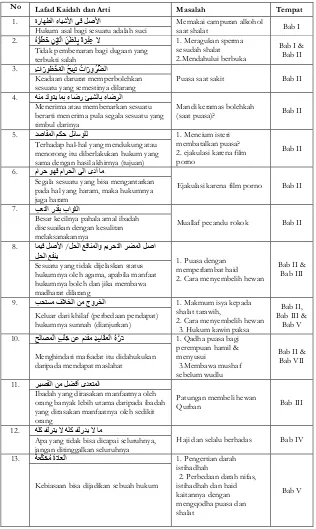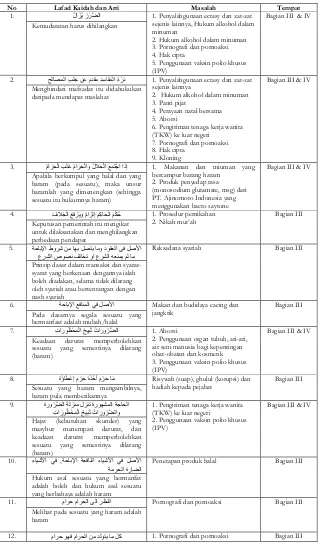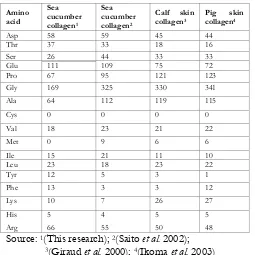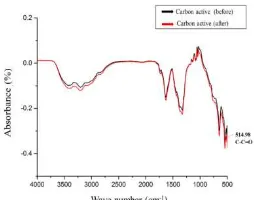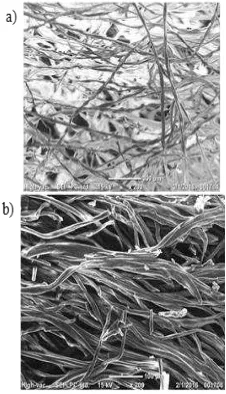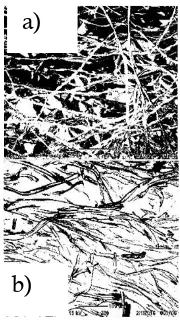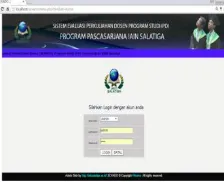AL INTERNA
TIONAL CONFERENCE
ON ISLAMIC S
TUDIES
A
IC
IS
2016
on Islamic Studies
st th
IAIN Raden Intan Lampung, November 1 -4 , 2016
Annual
Conference
International
AICIS
thThe 16 Annual International Conference
on Islamic Studies
2016
The Contribution of Indonesian Islam
to The World Civilization
Proceeding of
The 16
thAnnual International
Conference on Islamic Studies
Theme
The Contribution of Indonesian Islam
To The World Civilization
Sub Theme 1 :
The Contemporary Development of Islamic
Thought
Sub Theme 5 :
Islamic, Science and Technology
IAIN Raden Intan Lampung
November 1-4, 2016
Organized by Supported by
IAIN Raden Intan Lampung
Tim Editor:
Kamran As’at Irsyady, Lc, M.A
Kata Pengantar
Assalamu’alaikum Wr. Wb.
Buku ini berisi proceeding selected paper yang dipresentasikan pada
AICIS ke-16 pada tanggal 1-4 November 2016 di IAIN Raden Intan
Lampung. Berdasarkan catatan panitia bahwa jumlah submitted paper pada
AICIS tahun ini sebanyak 1345, kemudian dilakukan seleksi oleh Tim SC
dan diputuskan sebanyak 350 makalah yang dapat dipresentasikan dalam forum ini. Dari tiga ratus lima puluh dibagi menjadi dua kategori, yaitu
pertama, kategori A (selected presenter) terdapat 120 makalah yang wajib dipresentasikan dalam forum paralel AICIS 2016 yang ditanggung oleh
panitia. Kedua, kategori B terdapat 230 yang diberi kesempatan untuk
mempresentasikan papernya pada forum paralel namun atas tanggungan atau biaya pribadi atau lembaga.
Sebagimana lazimnya dalam sebuah konferensi, biasanya panitia selalu menerbitkan buku proceeding yang berisi kumpulan makalah yang dipresentasikan dalam forum tersebut. Begitu juga pada AICIS ke-16 kali ini, seluruh makalah kategori A sebanyak 120 diterbitkan menjadi buku ini.
Buku ini terdiri dari 4 buku, yaitu Buku 1 yang berisi gabungan
makalah sub tema 1 (The dynamics of Islamic Thought) dan 5 (Islam, Science and
Tchnology); Buku 2 berisi kumpulan makalah sub tema 2 (The Dynamics of Islamic Institution); Buku 3 berisi gabungan makalah sub tema 3 (The Heritage of Islamic Traditions) dan 6 (Area Studies); dan Buku 4 berisi kumpulan makalah sub tema 4 (The Interface between Islam and Globalization). Selain itu.
panitia juga akan menerbitkan pada jurnal ilmiah yang terindek scopus setelah
melalui penyempurnaan dan perbaikan supaya spektrumnya lebih besar dan dapat dibaca oleh masyarakat dunia.
Untuk itu, kami atas nama panitia mengucapkan terima kasih kepada seluruh presenter yang telah melengkapi tulisannya sesuai yang telah ditentukan oleh panitia dan juga kepada Tim SC yang telah dengan sabar dan teliti membaca satu per satu makalah yang masuk kemudian memilih dan memutuskan berdasarkan kategori A dan B. Terima kasih juga kami sampikan kepada Bapak Rektor IAIN Raden Intan Lampung yang terus mensupport dan memback-up panitia untuk bekerja semaksimal mungkin demi suksesnya AICIS ke-16 ini. Tak lupa kepada Bapak Dirjen Pendis, Prof. Dr. Phil. H. Kamaruddin Amin, MA dan Bapak Direktur Diktis, Prof. Dr. H. Amsal Bachtiar, MA yang telah mempercayakan penyelenggaraan AICIS ke-16 di IAIN Raden Intan Lampung.
Saya atas nama seluruh panitia mengucapkan selamat datang di
“Green Campus” IAIN Raden Intan Lampung dan selamat berkonferensi. Wassalamu’alaikum Wr. Wb.
Sambutan
Kepala Sub Direktorat Akademik dan Kemahasiswaan
Assalamu Alaikum Wr. Wb.
Pelaksanaan AICIS ke-16 tahun 2016 kali ini yang bertempat di Institut Agama Islam Negeri (IAIN) Raden Intan Lampung merupakan momentum dalam menjaga kesinambungan dan komitmen pengelolaan pendidikan Islam di tingkat perguruan tinggi. Sebagai salah satu wahana dalam pengembangan jaringan dan juga penguatan wacana untuk mendukung riset dan publikasi, maka pelaksanaan AICIS merupakan kegiatan yang sangat strategis dalam rangka mewujudkan perguruan tinggi yang berdaya saing.
Pendidikan tinggi saat ini menghadapi tantangan yang berbeda sama sekali dengan di zaman sebelumnya. Untuk menghadapi itu semua, maka hanya dengan kolaborasi dan kerjasama antara semua lembaga yang ada
sehingga mampu mewujudkan sebuah capaian akademik yang
memungkinkan. Direktorat Pedidikan Tinggi Islam menjadi salah satu pilar untuk mewujudkan amanah yang diemban Kementerian Agama RI. Salah satu usaha yang berkesinambungan adalah pelaksanaan AICIS dari tahun
ketahun. Tema tahun ini, Panitia Pengarah (Steering Committee) telah
merumuskan tentang sumbangsih Islam Indonesia terhadap peradaban dunia.
Pendidikan tinggi Islam walau belum berstatus sebagai universitas riset, tetapi prinsip-prinsip yang dikembangkan dalam pengelolaan perguruan tinggi mulai mengarah kepada pengembangan atmosfir riset. Untuk itu, forum AICIS dimaksudkan juga sebuah wahana untuk menjadi salah satu sarana dalam mengkomunikasikan hasil-hasil riset yang selama ini sudah dilaksanakan oleh setiap dosen di seluruh perguruan tinggi keagamaan Islam.
Terima kasih juga kepda segenap panitia yang sudah bekerja untuk kesuksesan kegiatan ini sehingga bisa menjadi sebuah kegiatan yang berkesinambungan dari waktu ke waktu. Untuk itu, semoga kesempatan ini menjadi salah satu kesempatan terbaik untuk senantiasa menjadi ikhtiar bagi pengembangan pendidikan tinggi Islam.
Wassalamu’alaikum Wr.Wb
Jakarta, Oktober 2016
Subdit Akademik dan Kemahasiswaan Kepala,
Sambutan
Rektor IAIN Raden Intan Lampung
Assalamu’alaikum Wr. Wb.
Pertama-tama saya ingin mengucapkan terima kasih kepada semua pihak yang telah memberikan kesempatan berharga kepada IAIN Raden Intan Lampung untuk menjadi penyelenggara AICIS ke-16 tahun 2016 ini. Kami dan seluruh civitas akademika IAIN Raden Intan Lampung menyambut baik dan gembira hal itu serta berkomitmen untuk menyukseskannya dengan seluruh kemampuan dan sumber daya yang ada. Untuk mewujudkan komitmen tersebut, kami telah mempersiapkan dengan baik seluruh kebutuhan sarana dan prasarana demi suksesnya acara tersebut. Pada AICIS tahun ini mungkin akan dirasakan kesan yang berbeda karena penyelenggaraan kegiatan AICIS tidak seluruhnya di hotel melainkan
di area kampus IAIN Raden Intan Lampung mulai dari plennary session
maupun paralel session kecuali upacara pembukaan. Oleh karena itu, seluruh
peserta AICIS ke-16 mulai dari pagi sampai sore akan beraktivitas di area kampus kami untuk mengikuti setiap kegiatan yang ada sambil menikmati
suasana hijau kampus (“green kampus”) kami.
Dalam kesempatan ini saya ingin mengucapkan terim kasih kepada Bapak Dirjen Pendis, Prof. Dr. Phil. H. Kamaruddin Amin, MA dan Direktur Diktis, Prof. Dr. H. Amsal Bakhtiar, MA yang telah mempercayakan kepada kami sebagai tuan rumah AICIS ke-16 ini. Kepada Gubernur Lampung Bapak Muhammad Ridho Ficardo, S.Pi, M.Si yang telah memberi dukungan penuh demi terselenggaranya AICIS ini.
Penghargaan juga saya sampaikan kepada seluruh panitia baik pusat maupun lokal yang tidak dapat saya sebutkan satu per satu dimana telah saling bekerjasama dalam menyukseskan acara ini.
Namun saya juga ingin memohon maaf kepada seluruh peserta konferensi, jika selama dalam penyelenggaraan AICIS ada hal-hal yang kurang berkenan baik mulai dari fasilitas, sarana dan prasarana maupun layanan. Mudah-mudahan dengan fasilitas yang ada seluruh peserta dapat menikmati dan memanfaatkannya sekalipun sangat terbatas.
Terakhir, saya sangat menyambut baik terbitnya proceeding ini yang tidak hanya sebagai dokumen penting seluruh kumpulan makalah yang dipresentasikan juga bisa menjadi buku referensi bagi perkembangan dan dinamika kajian islam di Indonesia. Selamat membaca..
Wassalamu’alaikum Wr. Wb.
Bandar Lampung, Oktober 2016 IAIN Raden Intan
Rektor,
Sambutan
Direktur Pendidikan Tinggi Islam
Assalamu’alaikum Wr. Wb.
Annual International Conference on Islamic Studies (AICIS) tanpa disadari telah memasuki tahun yang ke-16. Artinya tanpa disadari pula para peminat kajian Islam telah banyak memberikan kontribusi pemikirannya melalui forum ini. Dalam kurun waktu tersebut telah banyak rumusan-rumusan yang dihasilkan selain juga presentasi paper hasil penelitian maupun pemikiran dari para peminat dan pengkaji kajian Islam. Maka tak salah jika kita harus berbangga hati bahwa AICIS telah menjadi arena akademis PTKI yang mempertemukan berbagai latar belakang disiplin ilmu, pemikiran dan
keahlian, selain juga menjadi arena yang representatif dalam
mensosialisasikan gagasan, penyebaran ide dan positioning PTKI dalam
kancah global.
Mengingat forum semacam AICIS telah menjadi icon bagi
Kementerian Agama RI terutama Pendidikan Tinggi Islam, maka dalam setiap penyelenggaraan AICIS selalu ada dinamika yang terjadi sesuai dengan keberadaan PTKIN yang menjadi tuan rumah penyelenggaraannya. Dan hal yang patut disyukuri adalah dalam setiap penyelenggaraan AICIS jumlah paper yang masuk selalui melampaui target. Ini menunjukkan gairah para peminat kajian keislaman yang ingin turut serta dalam meramaikan forum ini setiap tahunnya sangat tinggi. Tahun ini saja menurut catatan
panitia terdapat 1345 submitted paper, namun setelah dilakukan seleksi
diputuskan ada 350 makalah yang akan dipresentasikan dalam forum ini. Sebagai salah satu sarana mempublikasikan makalah-makalah yang
terpilih tersebut, maka panitia membuatkan proceeding ini selain sebagai
bahan referensi juga menjadi bahan dokumetasi makalah-makalah yang dipresentasikan dalam AICIS.
Saya menyambut baik diterbitkannya buku proceeding ini oleh panitia AICIS ke-16 IAIN Raden Intan Lampung. Mudah-mudahan selain membantu para peserta AICIS dalam mediskusikan beragam topik baik plenari maupun paralel juga sebagi media diseminasi ide maupun gagasan para pengkaji kajian keIslaman kepada publik secara luas..
Wassalamua’alaikum Wr. Wb.
Jakarta, Oktober 2016
Direktorat Pendidikan Tinggi Islam Direktur,
Sambutan
Direktur Jenderal Pendidikan Islam
Assalamu’alaikum Wr. Wb.
Sebagai event yang bergengsi di lingkungan Direktorat Pendidikan
Islam, AICIS (Annual International Conference on Islamic Studies) telah
membuktikan bahwa para dosen, peneliti dan pengkaji Islam terutama di lingkungan PTKI mampu menelorkan gagasan, pikiran dan temuan yang brilian dengan topik dan tema yang relevan dengan perkembangan situasi sekarang ini dalam perspektif keislaman. Dalam setiap event AICIS selalu ada hal-hal terbaru yang terungkap dalam kajiannya sehingga selalu menarik untuk diikuti oleh peserta yang hadir dalam setiap sesionnya.
AICIS selain memang merupakan pertemuan tahunan dalam
mendialogkan hasil-hasil research terbaru untuk bisa dibaca, dikritisi dan diuji
oleh sesama pengkaji dan pemerhati kajian keislaman, juga telah menjadi
media membangun intellectual networking baik lokal maupun internasional. Di
sinilah urgensi kenapa AICIS tetap dipertahankan keberadaannya sampai sekarang karena AICIS telah mampu membuktikan sebagai wadah yang representatif bagi diseminasi hasil-hasil kajian Islam kepada publik.
Tren yang selalu menggembirakan dalam setiap AICIS adalah
kuantitas submitted paper selalu meningkat dari tahun ke tahun. Ini
membuktikan bahwa AICIS telah mempunyai tempat tersendiri di kalangan pengkaji kajian Islam di PTKI bahkan tak jarang ada peserta dari perguruan tinggi umum yang ikut ambil bagian dalam forum ini.
Saya selalu mengharapkan kepada panitia penyelenggara supaya paper yang akan dipresentasikan bisa dicetak, diterbitkan dan di-onlinekan supaya dapat dinikmati oleh komunitas akademik yang lebih luas tidak hanya oleh komunitas internal kita saja melainkan komunitas internasional.
Dan syukur alhamdulilah pada AICIS ke-16 ini, IAIN Raden Intan Lampung telah bersedia menerbitkan menjadi proceeding ini. Mudah-mudahan dapat memberi keMudah-mudahan para peserta AICIS ke-16 dalam menyimak setiap tulisan yang dipresentasikan dalam forum ini.
maupun luar negeri, partisipan dan peminat kajian keislaman yang hadir untuk menyemarakkan AICIS ke-16 ini, saya ucapkan terima kasih atas keikutsertaannya dalam forum ini.
Selamat berkonferensi..!!
Wassalamu’alaikum Wr.Wb.
Jakarta, Oktober 2016
Direktorat Pendidikan Islam Direktur Jenderal,
Daftar Isi
Kata Pengantar - iii Sambutan Rektor - iv Sambutan Direktur Diktis - v Sambutan Dirjen Pendis - vi Daftar isi -viii
Sub Theme : The Contemporary Development of Islamic Thought
1. Iftitah Jafar Review Of Qur‟Anic Translation Of
The Ministry Of Religious Affairs Of Republic Of Indonesia (A New
Reading Of Qur‟Anic Terms Of
Gender Equality)
2-18
2. Muhammad
Aniq Imam يمركلا نآرقلل ديدجيسفن يرسفت ونح
19-33
3. Khairun Nisa “Shifting Paradigm” Dalam Dunia
Tafsir (Studi Atas Interpretasi Kontekstual Dan Hierarki Nilai Abdullah Saeed)
34-47
4. Mohammad
Muhassin
Co-Reference In The Quran: A Study On The English Interpretation Of Surah Albaqarah By Abdullah Yusuf Al
48-64
5. Fadhli Lukman Digital Hermeneutics: The Qur‟An
In Indonesian‟S Facebook
65-84
6. Meirison
ةعيشرلا دصاقلما ءوض في ئياذغلا نمألا
85-987. Maulidi
ةيعشرلا مكاحألا ءانب في اهرود و ةحلصلما ةيرظن
(
فيوطلا دنع ةحلصلما تييرظن لىع ةيدقن ةيليلتح ةسارد
و ليبنلحا
يعفاشلا ملاسلا دبع نب زعلا
)99-134
8. Widyawati Hifzu Al-Ummah As A Higher
Objective Of Sharia: A Contribution Of A. Djazuli To Islamic Legal Thought
9. Sutomo Islamic Inheritance Law Division Of Property Inheritance Related To Heirs Of Different Religions (Study Of Jurisprudence Analysis Of The Supreme Court Of The Republic Of Indonesia)
151-166
10. Abbas Arfan Peran Kaidah-Kaidah Fiqh Dalam
Pengembangan Pemikiran Hukum
11. Heni Noviarita Telaah Kritis Zakat Dalam Perspektif
Makro Ekonomi
13. Adib Perkembangan Terjemah Al-Qur‟An
Di Indonesia: Studi Atas Karya-Karya
Terjemah Al-Qur„An Di Indonesia
Kontemporer
223-248
14. Firman Ideologisasi Agama Melalui Wacana
Keagamaan Jaringan Islam Liberal Betawi Sayyid Utsman Bin Yahya (W. 1914M)
265-278
Sub Theme 5 : Islam, Science and Technology
1. Amina Iraqy
Husaini
ملاسإلاا في ئياقولا بطلا
280-294
2. Muslih Islamization Of Knowledge: An Effort
To Build New Paradigm In The Unity Of Science
Synthesis Of Active Carbon Fiber From Pyrolyzed Cotton For Adsorption Of Fume Pollutants Application
5. Nihayatur
7. Abdul Muhid Muslim Survivors Exploration Study On
The Influence Of Religiosity, Religious Orientation, And Spiritual Well-Being Factors Toward The Resilience Of The Survivors Victims Of Lapindo Mudflow
10. Agung Sedayu Evaluasi Kualitas Pelayanan Proyek Pengadaan Perumahan dengan Tinjauan
13. Alamsyah Rekonstruksi Nusyûz Dalam Hukum
Islam Moderen (Studi Teks Keagamaan Dan Peraturan Perundang-Undangan dalam Konteks Kemoderenan)
462-470
14. Fathorrahman Pandangan Fikih Sosial Kh. Ali Yafie Dan Kontribusinya Terhadap Kajian Pembangunan Di Indonesia
THE CONTEMPORARY
DEVELOPMENT OF ISLAMIC
REVIEW OF QUR‟ANIC TRANSLATION OF THE MINISTRY OF RELIGIOUS AFFAIRS OF REPUBLIC OF INDONESIA
(A New Reading of Qur‟anic Terms of Gender Equality)
Iftitah Jafar
Abstract: This paper aims at reviewing Qur‟anic translation of the Ministry of
Religious Affairs on the key Qur‟anic terms of gender equality. The Qur‟an appreciates gender equality as shows in many verses which become general Qur‟anic view on woman. However, Qur‟anic
translation of the Ministry on these key Qur‟anic terms do not reflect this appreciation. Those key terms are nafsun wâḥida, qawwâmûn, nushûz, aḍribû and azwȃj which the translator team translated as a single person, protectors, leaving duties, beat, and wives respectively. These translations bring up problems, they are gender biased, discriminative, and lack of gender sensibility. This study offers alternative translations: stem cell, guardian, marital disloyalty, leave them and spouse. The study also offers solutions for improvement: 1.
Consulting research results on Qur‟anic translation in gender‟s perspectives, Qur‟anic translations that have gender sensitivity. 2.
Adopting hermeneutics in the process of translation. 3. Involving experts of gender in the translator team.
Key Words: Qur‘anic translation, Gender equality
Introduction
Translation the Qur‘an in gender‘s perspective is an opportunity as
well as a challenge. It is an opportunity because gender awareness becomes international concern along as the development of gender studies. Muslim youths, particularly students are interested in the new
horizon of understanding the Qur‘an, especially in gender equality. It is
also a challenge because people have been accustomed with classical
Qur‘anic translations and to some extent tends to be resistant. Some
scholars do not easily accept any new translation, especially in gender‘s perspective which they claim comes from the West. Qur‘anic translation of the Ministry of Religious Affairs like other Qur‘anic translations
experienced the case.
Qur‘anic Translation of the Ministry of Religious Affairs plays an
Singapore. The Minister of Religious Affairs established translator team whose responsibility to conduct translation activity. They are chosen from authorised people and acknowledged as scholars („ulamâ'), especially those who are experts the study of the Qur'an. It becomes a reference for all religious affairs, such as: text books, da„wa activities, law formulation, and
fatwa decision.
The Ministry of Religious Affairs of Republic of Indonesia has just
launched a news revised edition of its Qur‘anic translation. This revised
edition was published in 2014 and becomes the object of this study. However, the translator team did not specify the focus of revision whether its language or its contents. Previously revision was done to improve its language quality according to the advancement of Indonesian Language. The writer believes that the revision was partly a response of the review and criticism posted by researchers, especially Muhammad Thalib from Indonesian Mujahidin Council. However, as far as the writer concerned there was no a comprehensive research has been done on
Qur‘anic translation of the Ministry in gender‘s perspective. The writer has
conducted preliminary research on Qur‘anic translation of the Ministry on
Qur‘anic terms of gender in 2012. Research result shows that the
translation lacked of gender sensitivity, and it was firmly influenced by Arabic classical exegeses which are patriarchal.
Even though the Ministry has published new revised edition of its
Qur‘anic translation, revision is still being held by revision team. Religious
Minister hoped the revision would be finished at the end of 2018 or at the beginning of 2019. This review will be focused on this latest revised edition. Based on the aforementioned description the writer would like to
review Qur‘anic Translation of the Ministry of Religious Affairs of
Republic of Indonesia, especially the translation of key terms of gender equality. The writer will show some problems of the translation of some
Qur‘anic key terms of gender equality. Besides, the writer also will offer
alternative translation and some solution to improve the quality of translation.
This paper hopefully will contribute to the improvement of the quality of translation. In the view of Nasaruddin Umar, Vise Minister of the Ministry of Religious Affairs, revision of translation is an ongoing process. Moreover Quraish Shihab sees that revision is really needed because there is still certain inappropriate translation. Religious Minister, Lukman Hakim Saifuddin encouraged translator team to finish their work quickly, so that it will be published and used by the community. (Pinmas, 2016 July 18). Retrieved from http://www.kemenag.go.id. Discussion of the paper runs
as follows: Introduction, problem of translating key Qur‘anic term of
Problem of translating the key Qur‟anic terms of gender equality
In gender‘s perspective problem of translation of Qur‘anic translation of the Ministry can be traced on some key Qur‘anic terms of
gender equality, as follows: 1. Nafsun wâḥida
This term is mentioned in Sȗra al-An‘ȃm (6): 98, al-Nisȃ‘ (4): 1, al-A‗rȃf (7): 189 and al-Zumar (39): 6. In Sȗra al-An‘am (6): 98, ―nafsun wȃhida‖ was translated by translator team of the Ministry of Religious
Affairs as ―single person‖. In the footnote translator team give explanation that ―single person‖ is Adam as. In Sȗra al-Nisȃ‘ (4): 1, ―nafsun wȃḥida‖ was translated as ―oneself‖ while ―minhȃ‖ as ―from him‖. It is
mentioned in the footnote that ―from him‖ is part of his body (his rib)
Adam as. This translation based on ḥadȋth narrated by Bukhȃrȋ and Muslim. The translator also offers another interpretation of ―minhȃ‖ that
is ―the same elemen‖ i.e. earth in which Adam was created. In Sȗra al-A‗rȃf (7): 189, translator team translated ―zawjahȃ‖ as ―his wife‖. In Sȗra al-Zumar (39): 6, there is word ―tsumma‖between ―nafsun‖ and ―zawjahȃ‖.
The word ―nafsun‖ uses khalaqa, while ―zawjahȃ‖ conveys ―ja„ala‖.
Feminist Muslims as well those who are concerned to gender equality, questioned this kind of translation because it posits woman as a second creation or subordinated creation. Such understanding affects people in the way they treat women in society, job, education etc. Moreover, women become target of sexual harassment, they are waged less than that of men, and education opportunity for certain family is given more on men than women. They based their view on grammatical consideration of the verse, relation between verse on the same issue and
egalitarian teaching of the Qur‘an. Besides, hermeneutics especially the
way to grasp the intended meaning of the verse should be considered. In addition, to a certain extent, scientific exegesis (tafsȋr al-„ilmȋ) may
contribute in understanding Qur‘anic verses on gender equality.
The phrase ―created you from one single entity‖ itself is mentioned six times in the Qur‘an. The Arabic term translated here as ―living entity‖ is ―nafs‖. This word can be translated in a number of ways including
―soul‖, spirit, mind, animate being, human beings, person, humankind, life
essences, vital principle etc. Most of the traditional interpreters simply assumed that by nafs God meant Adam, the first man. However, it is a fact
that in the Qur‘an there is no indication of that. Moreover, the phrase translated as ―its mate‖, in Arabic zawjahȃ, can be used for the male as well
as female component of a pair. Besides the Qur‘anic emphasis on the
common source of all humanity from one nafs the creation of pairs is also
a recursive motive. One of the most significant Qur‘anic verse
time suggesting a peaceful co-existence is Q.49:13. This verse places piety
as the criterion of the noblest person in God‘s sight, not on gender or any
other category. (Mezit, 2011, p. 66).
According to some Muslim scholars, like Muhammad ‗Abdu, Muhammad Asad and Muslim feminists, Q.49:13 is a solid proof of the
Qur‘anic egalitarian paradigm. Among the around thirty passages dealing with the criterion of humanity in the Qur‘an, there is no indication that man was created prior to woman, that she was created from him or he is superior to her in any respect. Humanity is always designated by generic terms such as al-nȃs, al-insȃn or bashar. (Mezit, 2011, p. 66).
Having been studied related verses, Mustofa underlines that those verses do not discuss Adam and Eve. Sȗra al-A‗rȃf (7): 189 itself might be understood as Adam and Eve, however the next verse (190) states that after God bestowed both with a pious son they practised polytheism. Mustofa highlights that the term does not necessarily indicate Adam because there is no specific explanation which points to Adam. The term may mean the same origin or the same community, or universal creature that becomes the origin of man or woman. (Mustofa, 2013, p. 28). Nafs
refers to a single cell that becomes the origin of human both man and women, which the verse informed stem from the backbone or spinal cord. Mustofa supports his point with recent research of Germanic scientist, Prof. Karim Nayernia and his team which successfully created a primitive sperm from backbone. The discovery that has been tested on mice 2006 can also be made on human, and it was published in 2010-2011. (Mustofa, 2013, p. 30).
Regardless ethical issue, as Mustofa believes, the discovery credits
an interesting argument on Qur‘anic information that is previously
doubted. One of these information is the origin of sperm which stem from spinal cord. Biology previously concluded that sperm was formed in testicles, recent discovery, however in fact found new proof that spermatagonial which in testicles come from stem cell of spinal cord.
(Mustofa, 2013, p. 31). Understanding of Qur‘anic verses on biology
should be related with new development of biology as a part of correlation of verse (munȃsaba al-ȃya). This discovery enhanced scientific miracle of
the Qur‘an (i„jȃz al-„ilmȋ) and scientific exegesis (tafsȋr al-„ilmȋ).
2. Qawwâmûn
The translator team of the Ministry of Religious Affairs translated
―qawwâmûn‖ in Q.4:34 as ―protectors.‖ It is a new translation that the team offered in its revised edition (2014), previously it was translated as
―leaders.‖ However this translation brings up two problems: 1. The word ―protector‖ does not fully denote the exact meaning of ―qawwȃmȗn.‖ In
protection as well as of moral responsibility (1980, p. 109). He further wrote that the expression of qawwȃm is an intensive form of qȃ‟im which means ―one who is responsible for‖ or ―takes care of‖ a thing or a person. Thus qȃma „alȃ al-mar‟a signifies he undertook the maintenance of the
women or he ―maintained her.‖ Asad, for his part translates ―qawwȃmȗn‖
as ―Men shall take full care of women.‖ (1980, p. 109). However, Qur‘an is not stating a fixed rule, i.e. that all men are the maintainers/supporters of women, they are only so if they fulfill the criteria and it is referring to the wider duty of care/responsibility men have as mentioned above. It is conditional. 2. This translation is inadequate because it only conveys the
first part of the verse that is ―bima faḍḍala Allahu „alȃ ba‟ḍ‖ (Allah given
the one more (strength) than the other). It does not cover the second part
of the verse that is ―bimȃ anfaqȗ min amwȃlihim‖ (they support them from
their means).
On the ground of the first part the translation of team does not specify bounties that Allah bestowed to man as commonly seen in the
classical Qur‘anic translation. The implication of this translation among
others, man intrinsically has intellectual capacity, rational potential, and leadership more than women have (al-Mahallȋ, 2007, p. 76). Certain contemporary translators especially those whose gender awareness and sensitivity try to add specification like ―strength‖ or ―physical strength‖ as an explanation that put in the bracket. Protector signifies physical strength that mostly men have, ―their physical strength makes men in general and husbands in particular the better candidates to be of service to women and
family‖. (Bazargan, 2008, p. 33)
The verse ―bimȃ anfaqȗ min amwȃlihim‖ portrays man‘s function as a
financial provider. Provider conveys, among others income producers and jobholder. This mean that husbands will generally be responsible for the economic needs of women and this responsibility also makes them
qawwȃmȗn. (Shafaat, 2016 May 27). Retrieved from
http://www.islamicperspective.com There are two reasons behind the use of qawwȃm in the verse. The first reason is a man as protector due to their physical ability to protect women. The second is that men spend out of their wealth. A good translation should manifest these two distinctive parts of the verse. Yusuf Ali (2004) translated qawwȃmȗn as ―protectors
and maintainers‖ (p. 107) which reflects the two parts of the verse. However, the word ―guardians‖ as a translation of qawwȃmȗn is more
appropriate than ―protectors.‖
Farida Bennani, as quoted by Dahlia, argues that qawwȃmȗn refers to a duty, and not leadership or control. She argues that is derived from the root q-w-m which means ―to stand,‖ ―to take care,‖ or ―to guard.‖
responsibility of a man during the time his wife bears a child. Wadud Muhsin argues that a woman deserves qiwȃmah in mutually dependent relationship where she chooses child-bearing as her primary responsibility. She deserves physical protection and material sustenance;
otherwise, ‖it would be a serious oppression against the women.‖ The
verse therefore refers to the responsibilities where marital partners decide to undertake different roles within the marriage. (Dahlia, 2013, p. 38).
Hence, whenever a husband is unable to support his wife, he is no longer her caretaker. Salmȃn al-Qȃdah, a contemporary Islamic law scholar summarizes the legal implications of qawwȃmȗn as: Men are held liable for handling the affairs of women and are responsible for the women under their care. A husband, therefore, has the responsibility of taking care of his wife, protecting her, defending her honor, and fulfilling her needs regarding her religious and her worldly life. It does not mean as all too many people have falsely assumed that he has the right to behave obstinately towards her, subject her to his will, suppress her individuality, and thus heinously negate her identity (al-Qȃdah, n.d, p. 16).
3. Nushûz
3.1 Nushȗz of wife (Q. 4: 34)
In the Qur‘an the word ―nushûz‖ and its derivation is mentioned
five times in three context, those are standing to give others space (Q.58:11), commit an act of rebellion in the household life (Q.4:34), and lifting or arranging something ruined and scattered (Q.2:259). The translation team of the Ministry of Religious Affairs did not give directly translation of nushûz in Q.4:34. However, the translator team put an
explanation in the footnote ― leaving their duties as wife like leaving the
house without her husband‘s permission. (Kemenag. RI., 2014, p. 83). This shows inconsistency in translation issue compare to other Qur‘anic terms, such as ―qawwȃmȗn‖ in the beginning of the verse in which was
translated as ―protectors.‖ Some direct translation of term can be
considered: 1, Picktall translated as rebellion, 2. Shakir Ali translated as desertion, and The Presidency of Islamic Researches, IFTA, Call and Guidance (1410 H., p. 220) translated as disloyalty.
3.2 Nushȗz of husband (Q. 4: 128)
Like the verse 4: 34 in the case of women‘s nushȗz, translator team
did not put directly any translations to ―nushȗz‖ in Q.4:128. Regarding the
approach of translation, the translator team is consistent in treating the term. The problem arises if the readers try to look carefully explanations that are put in the footnote. In the footnote number 230 it says
her husband returns to him. In addition, footnote number 232 says that the intrinsic nature of human beings does not want to sincerely release some of their rights to others, but if their wives release some of them, their husbands are allowed to accept them. (Kemenag., 2014, p. 99)
The aforementioned explanation of the term under discussion is
unfair. In the case of women‘s nushȗz, women should be beaten to achieve
the aim. While in the same case for husband‘s nushȗz there is no husband-beating. Furthermore, to reach reconciliation wives are asked to release
some of their rights which do not happen in the case of husband‘s nushȗz. These kinds of explanation did not appear in the previous editions.
Additionally, the word nushȗz, which is generally translated as
―opposition‖ or ―rebellion‖ in 4:34, has another meaning. If we study 4:34
carefully we will find a clue that leads us to translate that word as
embracing a range of related ideas, from ―flirting‖ to ―engaging in an extramarital affairs,‖ indeed any words that reflect the range of disloyalty
in marriage, the clue is the phrase before nushȗz, wich reads: ―… they
honor them according to God‘s commandments, even when alone in their
primary.‖ This phrase emphasizes the importancy of loyalty in marriage
life, and helps us to make better sense of what follows. Interestingly, the same word, nushȗz, is used later in the same sȗra, in 4:128 but it is used to describe the misbehavior of husbands, not wives, as it was I 4:34. In our view, the translation of nushȗz, that is ―opposition‖ will not fit in both
contexts. However, the nushȗz as marital disloyalty, in a variety of forms, is clearly appropriate for both 4:34 and 4:128. (Yuskel, 2007, p. 20)
4. Idribû
The other term included in Sȗra al-Nisȃ‘ (4): 34, is ―adribûhunna‖
which the translator team of the Ministry of Religious Affairs rendered as
―beat them‖. Two problems emerged from this translation: first, extra
explanation ―if it is necessary‖ that translators put in the bracket preceded the imperative word ―beat them‖ (Kemenag. 2014, p. 84). This
explanation did not appear in the previous editions. Such explanation is not needed because the expression can be understood clearly based on logical sequence of three-step solution for nushȗz. If the second step
―leave her in beds‖ is not effective then the third step ―beat them‖
become a choice. There two explanations that should be considered in the translation, namely: 1. Sign for chronological order, such as first, next and the last. 2. ―With no pain‖ put in the bracket following the imperative
word ―beat them‖. If these explanations are considered, the translation of the verse will be ―If you fear of your wives‘ nushȗz remind them (first), (next) leave them alone in beds, and (the last) beat them (with no pain).
Second, ―beat them‖ which is crucial problem because it implies
husbands have the right to beat their wives. According to Yuksel, Many of us have heard this criticism from Christians, Atheists, Agnostics, and
others that ―verse 4:34 of the Qur‘an orders Muslim to beat their wives;
therefore, Islam is a male-dominant religion.‖ Though wife-beating is not a Muslim specially, and domestic violence is an endemic problem in the West as well as the East, the issue nevertheless is whether it is justified by God. Most people reading conventional translation of 4:34 feel that something is deeply wrong. How could God the Most Wise order us to beat our women? (Yuskel, 2007, p. 17)
The writer reflects the phrase ―beat them‖ by raising four
distinctive points. First, the translation does not support universal and
egalitarian message of the Qur‘an. The verse under discussion was a direct divine intervention into the lives of the young Muslim community, which still very much under the influence of pre-Islamic practices. This alleged authorization of husbands to hit their wives has either to be understood as a limitation of marital abuse in a tribal and brutal society of the seventh century and hence cannot be characterized as universal.
Muhsin claims that ―Qur‘an is universal in intent, but not in its contextual
epistemology. According to her, such a practice is ―unjust in the ways that human beings have come to experience and understand justice, and hence
unacceptable to universal notions of human dignity.‖ She also said ― I
could not believe that God would sanction harming another human being except in war‖. (Muhsin, 1999, p. 21).
According to Arlandson, (2016 July 04) textual reality of the Qur‘an
matches up with historical reality of seventh century Arabia. Gender inequalities and oppression in the Qur;an reflect the culture of seventh century desert nomads. He mentioned certain cases such as wife beating, polygamous marriage, witness, heritage and leadership. Retrieved from http://www.americanthinkers.com Khaled Abou El-Faḍl, Egyptian-born law profession and Islamic scholar at the University of California, Los
Angeles, said: ―The verse became an issue of debate and controversy
because of the ethics of the modern age, the universal notion of human
rights‖. El-Faḍl highlights that the practice refers to a rare public legal procedure that ended before 10th century.
The verse 4: 34 with three-step program, is often called a reform
over the violent practices of seven century Arabia, when the Qur‘an was
revealed. There was not a license for battery. Scholars said that other interpretation defining the heaviest instrument a man might employ as a twig commonly used as a toothbrush. Sheykh Ali Gomaa, the Islamic
scholar who serves as Egyptian grand mufti, said that the Qur‘anic verses
must be viewed through the prism of the era. The advice ‗is always broad
society deems it hateful and it will only serve to sow more discord. In the view of more liberal commentators, particularly women, the usual interpretation reflects the patriarchal practices of the Arabian Peninsula. This school holds that the sacred texts have been encrusted with medieval traditions that need to be scraped off like a layer of barnacles.
Second, ―beat them‖ is one of a number of possible meanings of
adribȗhunna in a variety of context. The word ―aḍribû‖ derived from
―ḍaraba‖ which is in the form of verb and noun is mentioned 58 times. In
Yuskel‘s survey, the word ―ḍaraba‖ has a variety of meaning, such as: 1)
To travel, to get out (Q.3:156, 4:101) 2) To strike (Q.2:60), 3) To beat (Q.8:50, 47:27), 4) To set up (Q.43:58, 57:13), 5) To give (example), (Q.14:24, 16:75), 6) To take away, to ignore (Q.43:5), 7) To condemn (2:61) 8) To seal, to draw over (Q.18:11), 9) To cover (Q.24:31), and 10) To explain (Q.13:17). (Yuskell, 2007, p. 19). In her study on the word ḍaraba, Affan (2007) underlines that this word is used more in the sense of giving an example or allegory that is 28 times, to travel and to beat 10
times. That is only a few used in the sense of ―to cut‖, ―to cover‖, and ―to kill‖. (2007, pp. 171-172). Haddad indicates that the verse 4:34 does not imply physical beating, since the Arabic root word of the verb
wadribȗhunna is also used to indicate washing the face with water and to travel the earth. (Ibrahim, 2013, p. 18)
Whenever the imperative verb ‗idrib‘ is used in the Qur‘an to denote
‗strike‘, whether idiomatically or otherwise, the Qur‘an always qualifies it
by making it clear by either one or both of the following: 1. What object
to use to strike?, and 2. What part of the body or ‗object‘ to strike?. Some
examples can be seen in the following verses: Strike the rock with your staff (Q.2:60; Q.7:160), strike him with a part of it (helter), (Q.2:73), strike of their heads (Q.8:12), strike off every fingertip of them (Q.8:12), strike out for them a dry path through the sea (Q.20:77), strike the sea with your staff (Q.2663), Take in your hand a bundle of rushes, and strike therewith. (Q.38:44).
However, only in verse 4:34 do we notice that the imperative verb
„idrib‟ neither tells us (1) what object to use to strike with nor (2) what part
of the body to strike. Without qualification, it would difficult to conclude
that the intention of the verb was ever to ‗strike‘. If „idribȗhunna‟ was
translated in the traditional manner to ‗strike them‘, then such an isolated,
unqualified rendition would leave it wide open for any aggressed husband to beat his wife in any manner, whenever he wanted, with any amount of given force. Therefore, verse 4:34 does not fit the Qur‘an‘s qualification of
‗idrib‘ when rendered to ‗beat‘. (Islam, 2016 May 27). Retrieved from
http://quranmessage.com Moreover, for physical punishment the Qur‘an conveys, for instance, ―jalada‖ in the case of adultery (Q.24:2), accusation
Third, the translation will cause internal conflicts with the meaning
of other Qur‘anic verses, and ḥadȋths. Q.30:21, for example, portrays men may dwell in tranquility with their spouses because God put love and mercy between them. We should also consider Q.24:2 which stresses that equal actions lead to equal punishment between men and women. By basing herself on these two verses, Bogaert insists that surely there is no reason why men and women should be treated differently for any lesser
marital problem. (2016 May 27). Retrieved from
http://www.cie.ugent.be/bogaert/bogaert4.htm Mezit, for her part argues that the verse has been traditionally understood that its injunction refers only to extreme cases of adultery of disregard of Divine regulations.
Even though the way of hitting one‘s wife was limited by the prophet to a non-violent, non-humiliating tap, in my view, it is hard to accept any physical chastisement as a way to solve problems among human beings. It
contrasts to the basis in which Qur‘an stands for an egalitarian and
respectful relationship between the sexes. (Mezit, 2011, p. 72)
Furthermore, Allah says in the Holy Qur‘an that one must meet bad
behavior with something that is better, not something that is worse, in
order to turn a hostile situation into a friendly one: ―Nor can goodness
and evil be equal, repel (evil) with what is better: Then will he between whom and thee was hatred become as it were thy friend and intimate‖ (Q. 41: 13). Therefore, the word adribȗ cannot really have meant ―to beat.‖ It
must mean something that is better than causing problems, and avoiding the problem certainly is exactly that. (Bogaert, 2016 May 27). Retrieved from http://www.cie.ugent.be/bogaert/bogaert4.htm
In addition, beating a wife, would contradict ḥadȋths of the Prophet who
repeatedly said: ―do not beat believing women!‖. The Prophet also said: ―(How odd it is that) one of you should whip his wife as a slave is whipped and then sleep with her at the end of the day‖. (Ḥadȋth narrated by Bukhȃrȋ and Muslim, on the authority of ‗Abd Allȃh ibn Zam‘a). Abu Hurayra narrated the Prophet said: ‖The most perfect of the believers in their belief are those with the best manners, and the nest of you are those
who are best with their wives.‖ The verse was revealed as an answer followed by Muhammad‘s words: ―Do not hit, only the evil ones hit‖.
Furthermore, in a ḥadȋthreported by ‗Ȃ‘isha, one of Muḥammad‘s wives, it is stated that he never hit any of his wives or any other persons indeed‖. (Muslim, Book of Virtues, no. 4296).
severe sanction. Moreover, physical chastisement may even cause worst situation. In line with this thought there are some translations, among others can be considered: ―scourge them‖ (Picthall), separate from them‖
(Yuskell), and ―leave them‖ (Bakhtiar). In Bakhtiar‘s view (2016 May 27),
the Prophet never beat anyone, much less his wives. When there were issues between husband and wife, he :went away.‖ It is interesting that the word idrib may also means ―to go away.‖ She stresses that we follow the
behaviour of the Prophet as well as the fairest of sayings of the Qur‘an as
Muslims are asked to do. Retrieved from
http://www.themosqueinmorgatown.com
5. Azwȃj
5.1. “Wives” Q.S. al-Taghȃbun (64): 14
When translating Q.64:14, for example, the translator team of the
Ministry of Religious Affairs translated ―azwȃj‖ as ―wives‖. The
translator team translated the first part of the verse as ―O those who believe! Indeed amongst your wives and children there are some will be
your enemies, so that, you should be aware of them.‖ In the footnote
number 844, translators comment that wives and children can sometimes lead their husbands or fathers to perform deeds which are religiously unacceptable.
There are three problems emerge from translation of this verse.
First, is translating ―azwȃj‘ as ―wives.‖ ―Wives‖ is one of various meaning
that can be derived from ―azwȃj. In his Mu‗jam Mufradȃt al-Fȃẓ al-Qur‘ȃn, al-Rȃghib al-Isfahȃnȋ explains that zawj means couple that can be used for things like a pair of shoos, animals, and for human (husbands and wive). (al-Isfahȃnȋ, n. d., p. 220). John Penrice, in his Dictionary and
Glossary of the Qur‟an states that ―zawj‖ denotes and individual when
consorting with another; that in which individuals are united, as a kind, species, class, sex. It also covers a pairs and a couple. (Penrice, 1990, p. 63) In addition, Muhsin, as quoted by Hassen (2012) argues that grammatically zawj is masculine. While, conceptually, it is neither
masculine nor feminine, and is used in the Qur‘an for plants (Q.55:52) and animals (Q.11: 40) in addition to humans. (p. 20)
Besides, the word ―amanȗ‖ in this verse and in the verse such as
Q.2: 153 meant ―those who believed‖ which refers to believing men and
believing women. Based on these two considerations the writer highlights
that ―azwȃj‖ in this verse should not be limited to mean ―wives‖ as
translator team did. The Qur‘an usually refers to ―wives‖ by means of a possessive construction (iḍȃfa) which containing one of the Arabic words for wife, imra‟a (women), nisȃ‟ (women), or zawj (spouses or mate) plural
Paraoh. (Muhsin, 1999, pp.32-33). Some recommended translations that should be considered are: companion, mate, spouse, couple, and spouse. (Penrice, 1990, p. 63) The writer realizes that in Indonesia those words are not familiar to use for official religious relation for marital status. However, we should try to choose appropriate meanings in terms of logical coherence, gender sensibility that are internationally accepted.
Second, is translating ―aduwwun lakum‖ as ―your enemies,‖ which is
a lexical translation of the word. This word does not necessarily to translate lexically, because it seems to be metaphorical. Members of family is one small integral unit part of community, they are tied together in a firm bound. It is not suitable to label or consider one of them as an enemy that should be aware of. Therefore, wives are not the enemies of
their husbands and vice versa. Furthermore, ―aduwwun‖ usually used for Satan (Q.2:208), and hypocrites (Q.63:4) both are the real enemies whom we should be aware of. It is highly recommended to convey exegetical translation (tarjama tafsȋriyya) which is proper and wiser than that of lexical translation (tarjama lafẓiyya). As a comparison the writer quotes
Mujahidin‘s direct translation of the first part of 64: 14, ―O those who
believe! Indeed, among your wives and children there are some will
interfere you in the struggle for the sake of God‘s religion.‖ (Thalib, 2011,
p. 558). Third, is considering wives as enemies which lead their husbands to commit wrong things. Gender group disagreed with this translation because in fact, husbands also may cause wives to do something wrong. Dariyati (2012 March 13) argues that in reality husbands also might be an enemy and may lead their wives to do something wrong. She takes an example husband forbids his wife to wear veil which is commended in Islam. We found also husbands lead his wives to practice prostitution. Retrieved from (p. 1) Having been criticised the translation by basing herself on al-Rȃghib al-Isfahȃnȋ‘s view of zawj, Daryati suggests ―couple‖
as an ideal meaning of the zawj in this verse.
5.2. “Companionship” Q.S. Ȃli „Imrȃn (3): 15
. . . For those pious men, with their Lord are gardens underneath rivers and pure azwȃj and contentment from Allah (Q.3:15). Translator
team of the Ministry of Religious Affairs translated the word ―azwȃj‖ in
this verse as ―wives.‖ The translation implied that only pious men will
have Hȗr al-In in Paradise while pious women will not have such kind of
companions. It can also be implied that Qur‘an not only gives a special
facilities to men by more than one wife in the world but also in the Hereafter. Men will be accompanied by many pure azwȃj in Paradise.
Some commentators use the Qur‘anic statements that there will be pure
terms that a pious man who practices self constraint should have multiple erotic pleasures as his objective. The use of plural azwȃj corresponds to
the use of plural form preceding it: for ―pious men.‖ The usage is meant
to indicate that companionship awaits those pious people (men and women) in their attainment of Paradise, not that each man will get
multiple wives. (Rehman, 2016 June 15) Retrieved from
http://themuslimstime.info/2013/06/29
The term Hȗr al-Ayn, in the eyes of Muhsin ( ) meant something specific to the Arabs patriarch, the primary audience of the Mekkan period. She was a sensual virgin youth female with large dark eyes, white skin, and a pliant character. The specific depiction of the companions of
Paradise demonstrates the Qur‘an‘s familiarity with the dreams and desires of those Arabs. The Qur‘an offers the Hȗr as an incentive to aspire after
truth. Muhsin insists that it is impossible to believe that the Qur‘an
intends white women with large eyes to represent a single universal description of beauty for all mankind. (p. 55). It is notable that after the
Makkan period, the Qur‘an does not use the term Hȗr again but it used
zawj to describe the companions of the Paradise. At least three verse support this point namely Q.2:25, Q.3: 15, and Q.4: 57. In these verses pious people do not exclusively refer to only specific gender but to both male and female. The word zawj itself should be translated as ―pairs‖
rather than ―wives‖ because it is a gender neutral term. The highest pleasures are the same for female inhabitants of Paradise as for males. With regard to eternal, both women and men equal in their potential to experience this highest transcendence.
Some solution to improve the quality of translation in gender‟s perspective
Reconstruction of translation should start from deconstruction on the root of problem that emerges in understanding. After that we
reformulate translation by doing reinterpretation on Qur‘anic verses and
prophetic tradition which deal with gender equality by applying contextual, interdiscipliner and comprehensive approach. In so doing we will have a
new translation which is really coherent with Qur‘anic principles that
shows the existence of gender equality. In relation to this case, the writer
recommends some solutions to improve the quality of Qur‘anic translation in gender‘s perspective, as follows:
Consulting Arabic dictionaries, dictionary of the Qur‟an, and encyclopedia of the Qur‟an
Qur‘an contributes to analyze the use of the words in the same sȗra or in the other sȗra. Dictionary of the Qur‘an can be consulted such as: 1.
Mufradȃt al-Qur‟ȃn, by al-Rȃghib al-Isfahȃnȋ, 2. Dictionary and Glossary of the
Qur‟ȃn, by John Penrice, and 3. Dictionay of the Qur‟an: Arabic Words-English Meaning, by Abd Mannan Omar. Encyclopedia of the Qur‘an contributes
in understanding the meaning of verses under certain topics.
Encyclopedia of the Qur‘an that can be used includes: 1. Encyclopedia of the
Qur‟an, by Jane McAuliff (ed.), 2. The Qur‟an: an Encyclopedia, by Oliver
Leaman, 3. Ensiklopedia Al-Qur‟an, by M. Quraish Shihab (ed.). Consulting Qur‟anic translations which have gender sensitivity
To produce a good Qur‘anic translation in Indonesian language the
translator should consult other Qur‘anic translation of other languages, especially English. There are many Qur‘anic translations are written in English with their certain excellence and short coming. In Robinson‘s
view, unfortunately none of those translations is entirely satisfactory. Those by Yusuf Ali and Marmaducke Pickthall, for example, are the most popular with Muslims. The former is the more accurate of the two, but both are generally reliable. (Robinson, 1996, p. 4). As a cross reference,
the following English Qur‘anic Translations is recommended to consult:
1. The Message of the Qur‟an, by Muhammad Asad, 2. The Glorious Qur‟an, by
Muhammad Ali, 3. The Holy Qur‟an: English Translation of the Meanings and
Commentary, by The Presidency of Islamic Researches. 4. Sublim Qur‟an, by Laleh Bakhtiar, 5. Qur‟an: A Modern Reformist Translation, by Yuskel et al. 6.
The Qur‘an Study: A New Translation and Commentary, by Seyyed
Hossein Nasr.
Consulting research results of Qur‟anic translation on gender
equality
Research is commonly a careful and a serious study by experts in certain field or discipline. Research results on the concept of gender
relation in the Qur‘an can contribute in the development and
improvement of the quality of translation. Some research results are
recommended to consult: 1. English Translation of the Qur‘an by
Women: Different or Derived? Dr. Phill. Thesis By Rim Hassen, University of Warwick. 2. The Socio-Political Implications of Translating the Qur‟an by Seyed Muhammad Alawi. University of Ottawa, Canada. 2. A Critical
Examination of Qur‟an 4:34 and its Relevance to Intimate Partner Violence in
Muslim Families by Nada Ibrahim and Mohamad Abdalla. Griffith
University, Brisbane, Australia. Qur‘an and Women: Rereading Holy Text
in Women‘s Perspective, by Amina Wadud Muhsin.
To create a more innovative and comprehensive translation it is recommended to involve related expert, especially in gender studies. Therefore, Muslim feminists, gender activists, those whose gender awareness and gender practitioners should be actively involved in translation activities. The Ministry of Religious Affairs usually translates
the Qur‘an by involving only those scholars with religious knowledge
beackground, particularly Qur‘an and Exegetical studies. Based on this
background the translation they produced mostly grasped a religious and
spiritual aspec of the verse. Meanwhile, as a matter of fact Qur‘an
encompass various concepts of any disciplines.
Adopting hermeneutics in the translation
In certain cases the meaning of the verse cannot be grasped by adopting lexical translation (tarjama lafẓiyya), meanwhile exegetical translation (tarjama tafsȋriyya) is also inadequate to represent the meaning. In such situation the meaning of the verse can be gained through analyzing the intended meaning of the verse (maqȃṣid al-ma„na). Qur‘anic
prescription of marital disloyalty in 4:34 can be properly treated with this method. The intended meaning of the verse is to make wives aware of their faults and quit from their resistance. This aim can be achieved by implementing certain approaches without beating wives, such as curtailing financial support or leaving them for certain period.
Final remarks
Translation of sacred texts is an unending activity, especially the
Qur‘an as a universal holy scripture. Qur‘an will always contribute in all
aspect of life, all disciplines include gender studies if it is continually translated in a new horizon. Qur‘anic translation on gender equality should always be reviewed according to the current issues. Regarding
Qur‘anic terms on gender equality, Muhammad Abdel Haleem proposes
three criteria namely: linguistic analysis of the text of the Qur‘an; what the
Prophet said and did; and what the Qur‘an says elsewhere about dealing
with wives in difficult situations. (2016 May 26). Retrieved from http://nour-dv.org.uk/tafseer-surah-434-
In approaching the issue translators should turn to the fundamental
rule of Qur‘anic exegesis: 1. ―Al-Qur‟ȃn yufassiru ba„ḍuhu ba„ḍa‖ (different
Bibliography
Printed Reference
Ali, Abdullah Yusuf. (2004). The holy Qur‟an: Original Arabic text with English translation and selected commentaries. Kuala Lumpur: Saba Islamic Media.
Affan, Afraniati. 2007. ―Dharaba,‖ in M. Quraish Shihab, Ensiklopedia Al-Qur‟an: Kajian kosakata. Jakarta: Lentera Hati.
Alawi, Seyed Muhammad. The socio-political implications of translating the Qur‟an. University of Ottawa, Ottawa, Canada.
Hassen, Rim. (2012). English Translation of the Qur‘an by Women:
Different or Derived? Dr. Phil Thesis. University of Warwick, Department of English and Comparative Literary Studies.
Ibrahim, Nada and Mohamad Abdalla. A critical examination of Qur‟an 4:34 and its relevance to intimate partner violence in Muslim families. Griffith University, Brisbane, Australia.
Kementerian Agama RI. 2014. Al-Qur‘an: Al-Qur‟anul Karim: Terjemah dan tajwid. Jakarta: al-Ziyadah.
Al-Mahallȋ, Jalȃl al-Dȋn and Jalȃl al-Dȋn al-Sayȗṭȋ. 2007. Tafsȋr al-Qur‟an al-„Aẓȋm. Vol.I. Jakarta: al-Haramayn Jaya Indonesia.
Mezit, Lejla. (2011) Language, gender and religion: An introduction into some gender-specific issue in religious texts, and the impact of language on the role of women in Judaism Christianity, and Islam. Thesis Master. University of Agder.
Muhsin, Amina Wadud. (1999). Qur‟an and women: Rereading sacred text with women perspectives. Oxford: Oxford University Press. Robinson, Neal. 1996. Discovering the Qur‟an: A contemporary
approach in a veiled text. London: SCM Press. Ltd.
Thalib, Muhammad. 2011 Al-Qur‟anul Karim: Tarjamah tafsiriyah.
Yogyakarta: Ma‘had al-Nabawi, Markaz Pusat Majelis Mujahidin. Yuskel, Edip, Layth Saleh al-Shayban and Murtha Schut-Nafeh. 2007.
Qur‟an: A reformist translation. USA.: Brainbow Press. Online Reference
Alwani, Zainab. (2016 June 15). The Qur‘anic concepts on gender relation.
Retrieved from http://www.fiqhcouncil.org/node/12
Bakhtiar, Laleh. (2016 May 27). The Qur‟an and wife beating. Retrieved from
http://www.themosqueinmorgantown.com/forum/tag/quran-434/
Bogaert, Linda. (2016 May 27). Does Qur‘anicverse 4:34 ―allow a superior
husband to beat his inferior, disobedient wife? Retrieved from http://www.cie.ugent.be/bogaert/bogaert4.htm
Euis Daryati. (2012 March 13). ―Bias gender dalam terjemahan.‖ Retrieved
Islam, Joseph A. A. (2016 May 27). Deeper look at the word ‗darab‘ (to
beat) in context of wives. Retrieved from
http://quransmessage.com/articles/a%20deeper%20look%20at%2 0the%20word%20dharaba%20FM3.htm
Luthfur Rehman (2016 June 15) Retrieved from
https://themuslimtimes.info/2013/06/29/gender-equality-in-the-holy-quran-in-the-beginning-man-and-woman-were-equal-2/ Pinmas. (2016 July 18). Menag. dorong revisi terjemah Al-Qur‘an segera
selesai. Retrieved from
http://www.kemenag.go.id/index.php?a=berita&id=364187 Shafaat, Ahmad. (2016 May 27). Tafseer Surah an-Nisa ayah 34.
يمصىًا نٓبصلٌَ سًسخ سيفه يرسفث ونح
مامٕا قَهٔب محمد
نٓبصلًا موَـً ةـمالدا
كامذ
-
ىعسوًا ىواخ
-
اَ سُهوسهٕا ةًزوِجم
aniq_imam@yahoo.com
طرَلـا
:
لوظٔب في مِفً نٔب صح ابمزو ذصًا تثرن لىؿ قَيخ لا ةاخن َهٔبت يمصىًا نٓبصلًا فظو
مالدا فظوًا اشُ شماُ لىؿ يرسفخًا
ام ٍسايخناو يمصىًا طيًا ةهوصم ذوسح غاسجا ؽ
ةكصفذم ةهاوحو تذسـذم خاوه نم زجـم نٓبصلًا نٕا .اـم ةكولذاو لةلالصا نم زوعخً لا
ذالخؾالا صُاؼم نؾ ةَ سفه سؿاوك ىؾاز سك يمصىًا نٓبصلًاف .سيفيًا ةهالدا اِمطٔب نم
و َخحج َت سًٔب ام اشُ زثأبو ، يرزٔبخًا حىاوهو لاـفهالا ةزاسمو
في وُو ،َثوؾذ صِػٔب
ًََٕا سخيه لؾ امذ ابهىاوحو ابهاـص في يلَلخًو ةَهاسوٕلاا سفيًا نوئ ص نم صٍاسٌ لعر
سفيًا في ام لىؿ زاخ وُو لإا ةَتصـًا ةًَاسٔب نم ةوَسٔب نم ام .اثًسح لإا لؿـًا
.ةًولٌَا ةًاولًا لغث برؿ ةَ سفيًا نياـلـا ٍشُ ايً يليً ايحظايخ ينح نٓبصلًاو ،ةَهاسوٕلاا
نياـلـا ءوض في لػ ةاخن مِف في صؼيًا سَـث ثاسازذ لىٕا ةخالذا ؽكاو نم اكلاعهاو
ةكزوًا ٍشُ للاذ نم رحاحًا نٕاف ،تاَلذا ؽكاو في ةََمـًا ةفَػوٌَ كاازذٕاو ،ةَ سفيًا
في ةَ سفه حملام لىؿ فضىٍو يمصىًا نٓبصلٌَ اسًسخ اَ سفه ايرسفث لواٌدً فوس
نٍسرفلـا جاصح
.
فلـا ثلٌكلًا
ةِحاذ
:
نٍسرفلـا جاصح ؛ ةَ سفيًا نياـلـا ؛ ةَهاسوٕلاا سفيًا ؛سيفه يرسفث
Abstract: The Quran is described a book not created with frequent response. Perhaps true to understand the origins of interpretation On the sidelines of this inclusive description widening the limits of the flexibility of the holy text. The Quran is miraculous in many ways and sporadic aspects, the most important is psychological aspect. Quran has taken into account the psychological bases for the manifestations of belief and emotion lanes and the areas of influence. As such, it kept pace with the human psyche affairs and penetrates in the coral and aspects which have not guided to science until recently. Based on the reality of the need to reconsider studies in understanding the book of God in the light of the psychological meanings and aware of the job process in real life. The researcher through this paper will address a new psychological interpretation for Quran And reveals the psychological features of the legacy of the interpretators.
